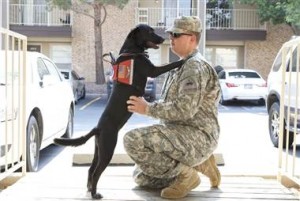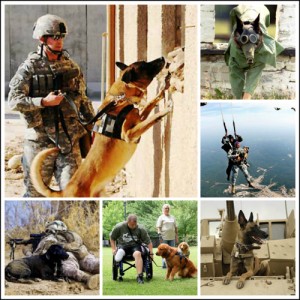Animals
Category
PTSD in Military Working Dogs
 In my new release, MEN UNDER FIRE, Sgt. Nick Welby isn’t the only veteran returning home from Afghanistan with PTSD. His partner Talley, a bomb-sniffing canine, is also struggling to overcome Post-traumatic Stress Disorder.
In my new release, MEN UNDER FIRE, Sgt. Nick Welby isn’t the only veteran returning home from Afghanistan with PTSD. His partner Talley, a bomb-sniffing canine, is also struggling to overcome Post-traumatic Stress Disorder.
Nick and Talley are strong characters in their own right and well-suited to the perilous plot in this story, but as an avid dog-lover, there was deeper motivation behind the creation of these two characters. I wanted to raise awareness about the struggle many of our two-legged and four-legged veterans face when they return home from active duty.
PTSD has become a well-known condition in the decades following military action in Iraq and Afghanistan. Both human and canine veterans require intensive support, therapy and treatment in order to manage the symptoms of PTSD. For dogs, these symptoms may include:
- Extreme fearful or emotional reactions
- Aggression
- Hyper-vigilance
- Anxiety
- Physical behavior such as panting, pacing, sleep issues
Researchers, including psychiatrists, statisticians and veterinary behaviorists, are finding anecdotal evidence that indicates PTSD can affect service animals much like it impacts humans. Dogs who are identified as having PTSD may receive medication in addition to conditioning/behavior modification to unlearn a PTSD behavior Approximately 50 percent of these dogs return to active duty, with the remainder being reassigned, retired or adopted out.
Not everyone is convinced “canine PTSD” is a real issue. It doesn’t matter what label or title is applied to the skittish, stressed out behavior exhibited by dogs returning from active military duty. What does matter is making sure all of our veterans–human and canine–receive the care, support and respect they need to return to a happy, fulfilled life. For more information, check out these resources:
Canine PTSD Blog
Integrative Veterinary Car Journal
Veterinary Practice News
Make a date with a whale
 Residents of the Pacific Northwest–indeed, everyone who lives on the West Coast of the U.S–have the unique privilege of living along the migration routes of several different species of whales, including orcas, minkes, humpbacks and grays. Sightings occur throughout the year, but March launches prime whale-sighting season.
Residents of the Pacific Northwest–indeed, everyone who lives on the West Coast of the U.S–have the unique privilege of living along the migration routes of several different species of whales, including orcas, minkes, humpbacks and grays. Sightings occur throughout the year, but March launches prime whale-sighting season.
If you’re planning a visit to Seattle, consider signing up for a whale-watching tour. TV and photos cannot capture the true majesty of these incredible mammals, and there is something awe-inspiring about seeing them in their natural habitat.
The best time to go whale watching depends on what type of whale you hope to see. These recommendations were collected from information provided by Island Adventures Whale Watching.
Orca: May-September
Minke: August
Gray: March-AprilHumpback: October-November
These photos were taken by a friend of mine in Hawaii. Pretty amazing, aren’t they?
Thank you for your service, Woof!
 Dogs have been used in war from since the start of civilization. The Greeks and Romans used dogs as sentries or patrols, although they were also taken into battle. It was during the Seminole Wars that dogs were first officially used in the U.S. military. Since then, dogs have served as messengers, guard dogs and propaganda mascots. They have also been used in experimental medical treatments, detection and tracking, scouts, law enforcement, search and rescue, drug and explosives detection, therapy dogs and for intimidation purposes.
Dogs have been used in war from since the start of civilization. The Greeks and Romans used dogs as sentries or patrols, although they were also taken into battle. It was during the Seminole Wars that dogs were first officially used in the U.S. military. Since then, dogs have served as messengers, guard dogs and propaganda mascots. They have also been used in experimental medical treatments, detection and tracking, scouts, law enforcement, search and rescue, drug and explosives detection, therapy dogs and for intimidation purposes.
The bond between handlers and their combat canines is extraordinary, and holds special significance. Because many handlers and canines rotate through platoons or join units that have been together for months, even years, they are often outsiders. The strength of this partnership makes it easier to endure the feeling of being an outsider.
For injured and wounded veterans, dog therapy has proven exceptionally effective in aiding in recovery from PTSD. They also serve as companion animals and service dogs.
Dogs are known for their loyalty, affection and faithfulness. These characteristics are what make military dogs four-legged heroes.
Keep pets safe during the holidays
While the glittering lights, prettily wrapped packages and delicious treats all make for holiday fun, these same festive elements can pose risks for pets. Keep the season merry and bright by pet-proofing your holidays with these tips from the American Veterinary Medical Association:  Seasonal decorations can be hazardous to pets. The holidays bring lots of seasonal home decorations, such as candles, decorated trees, and potpourri. Pet owners are urged to make sure pets are not left alone in decorated rooms to avoid potential dangerous situations. Don’t allow pets to chew on power cords or consume decorative elements such as tinsel.
Seasonal decorations can be hazardous to pets. The holidays bring lots of seasonal home decorations, such as candles, decorated trees, and potpourri. Pet owners are urged to make sure pets are not left alone in decorated rooms to avoid potential dangerous situations. Don’t allow pets to chew on power cords or consume decorative elements such as tinsel.
Holidays plants can be poisonous to pets. Some holiday favorites such as mistletoe, holly, and lilies are actually harmful to pets. These plants should be kept out of pets’ reach.
People treats aren’t necessarily pet treats. One of the main challenges that comes along with the holiday season is the excess of food. It is encouraged that you keep “people food” in places that cannot be accessed by your pets. As your guests if they can do the same. Pet owners are urged to keep human treats away from pets. Specifically treats that contain chocolate, Xylitol, grapes/raisins, onions or other foods that are toxic for pets.
Pets react to holiday stress, just like people do. The holidays tend to bring lots of family and friends together in one place. Some pets get scared or excited around crowds or when they see new faces. It’s advised that pets are placed in a separate room while guests are visiting. Holiday travel and spending time in an unfamiliar environment can also cause disruptive or problematic behavior in pets. If your pet is unaccustomed to travel, consider hiring a pet sitter or boarding them at a qualified facility.













